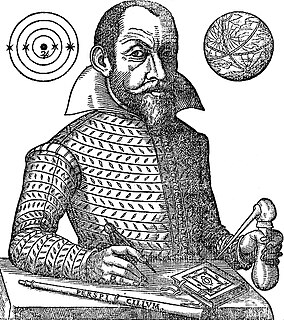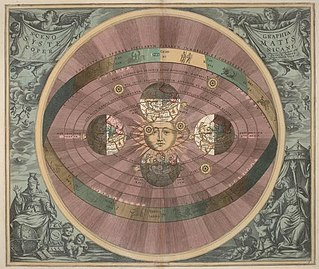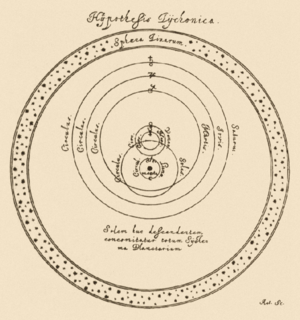
The Galilean moons are the four largest moons of Jupiter—Io, Europa, Ganymede, and Callisto. They were first seen by Galileo Galilei in December 1609 or January 1610, and recognized by him as satellites of Jupiter in March 1610. They were the first objects found to orbit a planet other than the Earth.
Astronomy is the oldest of the natural sciences, dating back to antiquity, with its origins in the religious, mythological, cosmological, calendrical, and astrological beliefs and practices of prehistory: vestiges of these are still found in astrology, a discipline long interwoven with public and governmental astronomy. It was not completely separated in Europe during the Copernican Revolution starting in 1543. In some cultures, astronomical data was used for astrological prognostication. The study of astronomy has received financial and social support from many institutions, especially the Church, which was its largest source of support between the 12th century to the Enlightenment.

Johannes Kepler was a German astronomer, mathematician, and astrologer. He is a key figure in the 17th-century scientific revolution, best known for his laws of planetary motion, and his books Astronomia nova, Harmonices Mundi, and Epitome Astronomiae Copernicanae. These works also provided one of the foundations for Newton's theory of universal gravitation.

Tycho Brahe was a Danish nobleman, astronomer, and writer known for his accurate and comprehensive astronomical observations. He was born in the then-Danish peninsula of Scania, which became part of Sweden the century afterwards. Tycho was well known in his lifetime as an astronomer, astrologer, and alchemist. He has been described as "the first competent mind in modern astronomy to feel ardently the passion for exact empirical facts". Most of his observations were more accurate than the best available observations at the time.

SN 1604, also known as Kepler's Supernova, Kepler's Nova or Kepler's Star, was a Type Ia supernova that occurred in the Milky Way, in the constellation Ophiuchus. Appearing in 1604, it is the most recent supernova in our galaxy to have been unquestionably observed by the naked eye, occurring no farther than 6 kiloparsecs from Earth. Prior to the adoption of the current naming system for supernovae, it was named for Johannes Kepler, the German astronomer who described it in De Stella Nova.

Sidereus Nuncius is a short astronomical treatise published in New Latin by Galileo Galilei on March 13, 1610. It was the first published scientific work based on observations made through a telescope, and it contains the results of Galileo's early observations of the imperfect and mountainous Moon, the hundreds of stars that were unable to be seen in either the Milky Way or certain constellations with the naked eye, and the Medicean Stars that appeared to be circling Jupiter.

Simon Marius was a German astronomer. He was born in Gunzenhausen, near Nuremberg, but spent most of his life in the city of Ansbach. He is most known for making the first observations of the four largest moons of Jupiter, before Galileo himself, and his publication of his discovery led to charges of plagiarism.

Heliocentrism is the astronomical model in which the Earth and planets revolve around the Sun at the center of the Universe. Historically, heliocentrism was opposed to geocentrism, which placed the Earth at the center. The notion that the Earth revolves around the Sun had been proposed as early as the 3rd century BC by Aristarchus of Samos, but at least in medieval Europe, Aristarchus' heliocentrism attracted little attention—possibly because of the loss of scientific works of the Hellenistic period.

The Dialogue Concerning the Two Chief World Systems is a 1632 Italian-language book by Galileo Galilei comparing the Copernican system with the traditional Ptolemaic system. It was translated into Latin as Systema cosmicum in 1635 by Matthias Bernegger. The book was dedicated to Galileo's patron, Ferdinando II de' Medici, Grand Duke of Tuscany, who received the first printed copy on February 22, 1632.

The Tychonic system is a model of the Universe published by Tycho Brahe in the late 16th century, which combines what he saw as the mathematical benefits of the Copernican system with the philosophical and "physical" benefits of the Ptolemaic system. The model may have been inspired by Valentin Naboth and Paul Wittich, a Silesian mathematician and astronomer. A similar model was implicit in the calculations a century earlier by Nilakantha Somayaji of the Kerala school of astronomy and mathematics.

The celestial spheres, or celestial orbs, were the fundamental entities of the cosmological models developed by Plato, Eudoxus, Aristotle, Ptolemy, Copernicus, and others. In these celestial models, the apparent motions of the fixed stars and planets are accounted for by treating them as embedded in rotating spheres made of an aetherial, transparent fifth element (quintessence), like jewels set in orbs. Since it was believed that the fixed stars did not change their positions relative to one another, it was argued that they must be on the surface of a single starry sphere.

Giovanni Battista Riccioli was an Italian astronomer and a Catholic priest in the Jesuit order. He is known, among other things, for his experiments with pendulums and with falling bodies, for his discussion of 126 arguments concerning the motion of the Earth, and for introducing the current scheme of lunar nomenclature. He is also widely known for discovering the first double star. He argued that the rotation of the Earth should reveal itself because on a rotating Earth, the ground moves at different speeds at different times.

Cosimo II de' Medici was Grand Duke of Tuscany from 1609 until his death. He was the elder son of Ferdinando I de' Medici, Grand Duke of Tuscany, and Christina of Lorraine.

Niccolò Zucchi was an Italian Jesuit, astronomer, and physicist.

Michael Maestlin was a German astronomer and mathematician, known for being the mentor of Johannes Kepler. He was a student of Philipp Apian and was known as the teacher who most influenced Kepler. Maestlin was considered to be one of the most significant astronomers between the time of Copernicus and Kepler.

The Copernican Revolution was the paradigm shift from the Ptolemaic model of the heavens, which described the cosmos as having Earth stationary at the center of the universe, to the heliocentric model with the Sun at the center of the Solar System. This revolution consisted of two phases; the first being extremely mathematical in nature and the second phase starting in 1610 with the publication of a pamphlet by Galileo. Beginning with the publication of Nicolaus Copernicus’s De revolutionibus orbium coelestium, contributions to the “revolution” continued until finally ending with Isaac Newton’s work over a century later.

Mysterium Cosmographicum is an astronomy book by the German astronomer Johannes Kepler, published at Tübingen in 1597 and in a second edition in 1621. Kepler proposed that the distance relationships between the six planets known at that time could be understood in terms of the five Platonic solids, enclosed within a sphere that represented the orbit of Saturn.

Copernican heliocentrism is the name given to the astronomical model developed by Nicolaus Copernicus and published in 1543. This model positioned the Sun at the center of the Universe, motionless, with Earth and the other planets orbiting around it in circular paths, modified by epicycles, and at uniform speeds. The Copernican model displaced the geocentric model of Ptolemy that had prevailed for centuries, which had placed Earth at the center of the Universe. Copernican heliocentrism is often regarded as the launching point to modern astronomy and the Scientific Revolution.

Galileo di Vincenzo Bonaiuti de' Galilei was an Italian astronomer, physicist and engineer, sometimes described as a polymath, from Pisa. Galileo has been called the "father of observational astronomy", the "father of modern physics", the "father of the scientific method", and the "father of modern science".

The Copernican Question: Prognostication, Skepticism, and Celestial Order is a 704-page book written by Robert S. Westman and published by University of California Press in 2011 and in 2020 (paperback). The book is a broad historical overview of Europe's astronomical and astrological culture leading to Copernicus’s De revolutionibus and follows the scholarly debates that took place roughly over three generations after Copernicus.

























